

UNLIMITED AIR RACING - RENO 2021
Text and Photos by Dan Whitney
Published 09 Feb 2022
High-Resolution Version in the Members Section
In September 2021 Unlimited class air racing got going again with the 57th STIHL National Championship Air Races, restarting after the COVID-19 hiatus of 2020. This, the world’s premier air racing event, is held at Nevada’s Reno Stead Field, a site uniquely configured to host the World’s Fastest Motor Sport. It features two long runways within the course, in an open desert arena ringed by adjacent mountains that gives spectators an unobstructed view of the entire course. The races were held this past September 16 thru 19h, and featured the usual seven classes of closed-course racing ‑ Biplanes, Formula One, T-6s, Sport, Jets and Unlimiteds, and the new STOL Drag Racing class as well. Added attractions included some outstanding airshow performers filling in between races as well as Military demonstrations by the F-35A Lightning II and MV-22 Osprey, punctuated by the majestic performance of the USAF Thunderbirds.
All together there were 54 races in four and a half days of racing, with 107 Pylon racers and 25 STOL Drag racers on the field. For a week, “Reno” is a busy place with a lot of excitement and action: just what you would expect of the World’s Fastest Motor Sport! The racing was done before a crowd estimated to total 115,000 people, all fresh out of COVID-19 quarantine and enjoying fresh air, open spaces and lots of colorful air racing.
The Unlimited Division field, made up of WWII and Korean War era warbirds, featured 14 racers, up from 12 in 2019 and 11 racers in 2016. The racers were organized into “Silver” and “Gold” Heats, as determined by qualifying speeds, with the winner of the Silver Heats eligible to move up to the Gold division. There were two Unlimited races each day, Friday through Sunday, and one on Thursday. The weather was again perfect for air racing, lots of sunshine, mostly moderate winds, and no serious smoke from the regional wildfires.
The emphasis on safety again paid off, with no major incidents occurring during the week.
Unlimited Overview
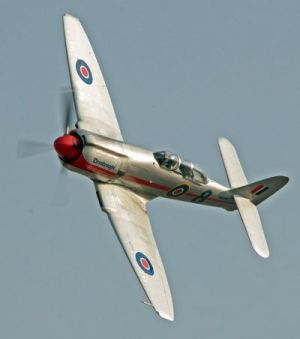 |
| Dreadnought, the R-4360 powered Sea Fury Mk T20 was piloted this year by Joel Swager. Here he is coming by pylon 2 during the Friday Unlimited Gold heat. Joel won the race with a speed of 420.319 mph. On Sunday he repeated this performance, and with a speed of 426.896, finished well ahead of Miss America, who was subsequently disqualified for having flown too high. |
This year’s Unlimited field included ten P-51D Mustangs, three Sea Furys, and an Allison V-1710 powered P-63C. There were again two highly modified racers, the Sanders R-4360 powered Sea Fury Dreadnought, and Dr. Brent Hisey’s P-51D Miss America, fitted with a special racing Merlin and a number of new airframe improvements. The other racers were basically “stock,” with the differences being the degree of airframe cleanup and the willingness to run their engines at higher power levels.
Please see the table at the end of this article for a complete listing of the Unlimited racers, the airplane’s name, and the pilot's names, along with their speeds and finishing positions for qualifying and in each heat.
The Unlimited Races
With the exception of the Sunday Silver and Gold races, the races are of six laps duration, a length of 46.99 miles. For Sunday’s finals, the Silver is seven laps, 54.90 miles, and the Unlimited Gold race is for eight laps, 62.81 miles.
All racers have to be on the field the Saturday before race week. Qualifying begins on Monday and extends to noon Wednesday. That afternoon the airshow and non-Unlimited classes begin racing, with the first Unlimited race occurring Thursday.
Thursday
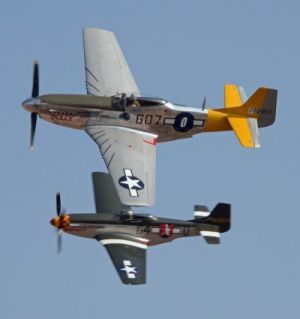 |
| In Thursday’s Silver heat 1A, the first Unlimited race of the week, Mustang #0, Spam Can/Dolly, is passing inside of stable mate Wee Willy II while battling it out for 2nd and 3rd positions. These two were very evenly matched, finishing within a thousandth of a second of each other with speeds of 308.910 and 308.909 mph respectively. This really close racing was fun to watch! |
Traditionally the fastest Gold Class Unlimited racers get the day off; this meant that Sea Furys Dreadnought, Argonaut, and #924G, along with Mustangs Goldfinger, Speedball Alice, Blondie and Sweet and Lovely could stay in the pits and continue preparations for the hard running to come. This left another seven racers, all with inline engines, to compete in the Silver heat, a race that was dominated by Brent Hisey in his modified Mustang Miss America. Miss America was in this “Silver” heat race as a consequence of failing to post an acceptable qualifying time earlier in the week. Without really pushing Miss America he won the race by some 40 seconds, with a speed of 333.937 mph. He was followed by two pairs of Mustangs fighting for position, the first pair being stable mates from the Planes of Fame Air Museum, Spam Can and Wee Willy II who finished within 0.002 seconds of each other, posting speeds of 308.910 and 309.909 mph respectively. Lady B and Bunny fought for fourth and fifth, with Lady B taking the position with a speed of 291.735 mph. Tom Nightingale in Bunny then bested stable mate P-63C Pretty Polly, piloted by Patrick Nightingale by a second at 288.052 versus 287.546 mph. Both aircraft are from the Palm Spring Aviation Museum.
Friday
The Unlimited Silver heat was another all “liquid-cooled” engine race with six Merlin powered Mustangs and the single Allison powered P-63C, Pretty Polly.
Robbie Patterson in Wee Willy II won the race at 318.668 mph, two seconds ahead of Jeff LeVelle in his new Mustang Sweet and Lovely. Jeff has been a long time Reno competitor, and often wins, in the Sport Class with his turbosupercharged Glasair III. This was his first race in the Unlimited Class and he finished second at 317.579 mph in the Heat.
By the time they got to the end of the race the racers were strung out, being some 5 to 10 seconds apart.
Friday afternoon we got to see all of the “Gold” Unlimiteds racing for the first time. The race was won by Joel Swager in the R-4360 powered Sea Fury Dreadnought, at 420.319 mph. He was being challenged by the P-51D Miss America throughout the race, however following the race Miss America was disqualified for having flown too high. Second and Third places were awarded to the Sanders Sea Furys Argonaut (R-2800 powered), flown by Sherm Smoot, and #924G (Bristol Centaurus powered), flown by Dennis Sanders. They posted speeds of 362.800 and 356.966 mph respectively. Mike Brown’s P-51D Mustang Goldfinger, piloted by Bernie Vasquez, was fourth at 340.176 mph. The sixth and final place in this race went to Brant Seghetti in his Mustang Blondie, finishing at 311.487 mph.
Saturday
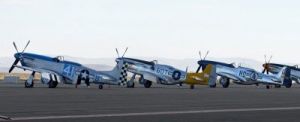 |
| Silver Class Unlimited Racing Mustangs lined up on ramp prior to their Saturday heat. |
The 47 mile Silver heat was to start at Hi-Noon and would be an all “in-line, liquid-cooled” event with seven racers, all Mustangs except for the P-63C Pretty Polly. As it turned out there were two interesting “races” within the Heat, one at the front between Mustangs Wee Willy II and Sweet and Lovely, with them finishing one – two, with speeds of 321.083 and 320.541 mph respectively, with Robbie Patterson again taking first, as he had on Friday, and also besting his Friday and Qualifying speeds. Shows what having a competitor will do! The “race” at the back was between Man O’ War, Pretty Polly and Bunny. They posted speeds of 284.282, 283.701 and 281.675 mph respectively; front to back they were within a five second span. Some good fun racing was had!
Saturday’s Gold Heat was a disappointment for all. Strong winds came over the Sierras with a passing front and made high-speed, low-level flying extremely hazardous – consequently the late afternoon Unlimited race was canceled.
Sunday
 |
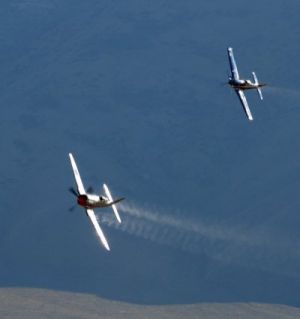 |
| In Sunday’s Silver Final Mustangs Man O’ War and Bunny are battling it out for 5th and 6th positions. These two were quite evenly matched, finishing within a fraction of a second of each other with speeds of 297.162 and 296.872 mph respectively. Their “race within the race” made for exciting viewing for race fans. | The race between Dreadnought and Miss America seen from Pylon #2 during Sundays Gold Final. They maintained this little separation throughout the eight lap race. The “contrails” are from spray water used to cool Dreadnought’s oil coolers and Miss America’s coolant radiator. Dreadnought pilot Joel Swager said after the race that he was overheating and would have had to back off if the race had gone another lap. |
The day broke beautiful, and with little wind to worry the plans. It was a full day of racing with all of the classes seeking to name their Silver and Gold Winners, with the first Unlimiteds going for the Silver in the late morning seven lap, 54.9 mile race.
Jeff LaVelle quickly took the lead in Sweet and Lovely, finishing in 10:04 minutes with a speed of 327.402 mph, and ten seconds ahead of second place Michael Pfleger in Lady B. A good fast Silver race, but not as fast as the 400.834 mph Jeff posted in his Sport Gold winning Glasair III later in the day!
This race was another that featured “races within the race.” In this case Wee Willy II and stable mate Spam Can duked it out for third and fourth place, Robbie Patterson in Wee Willy II taking third at 312.841 and Mark Moodie in Spam Can at 312.721 mph. A tenth of a second apart – and bragging rights for the year!
The “race” at the rear was between Man O’ War and Bunny, with Pretty Polly far behind. Ken Gottschall in Man O’ War finished at 297.162 mph and Tom Nightingale in Bunny at 296.872 mph. A difference of 0.65 seconds, and fun to watch!
After a week of suspense, the canceled Saturday Gold Heat, and all of the surrounding activity, it was now time for the finale – The Unlimited Gold! This is the longest race of the week, eight laps totaling 62.8 miles, which provides opportunities for some racers to fail and others more time to exploit their opponents’ vulnerabilities. Seven Unlimited racers were in the Gold final. Joel Swager in Dreadnought was the obvious favorite, but the bets were on Miss America. After her misfortunes of the week, not posting a qualifying time, being disqualified on Friday, and the Heat being canceled on Saturday, she was looking good, and primed to place a Merlin once again in the Reno Winners Circle.
The whole theory of the R-4360 powered Dreadnought is that the Sea Fury airframe, powered by the world’s largest radial engine, only needs to operate at take-off power to best the field. While others may be faster; slow and steady will win the day – and its’ been proven in the past. Dreadnought is not “slow,” besting the entire Unlimited Class by qualifying at 430.788 mph, 47 mph faster than any other qualifier.
Miss America was clearly the competition though starting from the outside position. He soon pushed Dreadnought, forcing Joel Swager to “pour on the coal” to stay ahead, even though just barely. Unfortunately for Miss America the wake from Dreadnought is substantial and when attempting to pass, Brent Hisey again exceeded the 250 foot height limitation and was disqualified. A sour ending to what had been looking like a good week for Hisey and his hard working crew.
Dreadnought and Miss America were the only racers to finish eight laps, as they had both lapped the field. With the “race” over Argonaut, #924G and Goldfinger finished seven laps, posting speeds of 359.961, 354.937 and 345.446 mph respectively. Mustangs Speedball Alice and Blondie both finished only six laps and were in fifth and sixth respectively with speeds of 315.767 and 311.489 mph, both having been lapped – twice!
The Unlimited Racers
The following descriptions of each airplane are given in the order in which they qualified. See the table at the end of this article for their speeds and placement in all of the Unlimited Heats.
#8 Dreadnought, a Hawker Sea Fury T.Mk.20, re-powered with a Pratt & Whitney R-4360-63A, rated for takeoff at 3,800 bhp at 2,800 rpm, and piloted this year by Joel Swager, who had piloted Dreadnought to its 2018 Gold Final win. This big, handsome and heavy racer brings dependability to Unlimited racing – not having to push the engine to levels far beyond its original rating is beneficial, if you have enough power. Dreadnought is fast, having set a new qualifying record at 452.737 mph back in 1986, though qualified this year at 430.788 mph. In 2019 she qualified at a conservative 417.868 mph, so the threat of the improved Miss America caused Dreadnought to “step it up.” During the Friday Gold Heat Dreadnought ran 420.319, and then won the Sunday Gold Final with a speed of 426.896 mph, while lapping the entire field, twice, with Miss America close behind! Quite an accomplishment in an 8:50 minute, 62.8 mile long race, though it was reported that the engine was beginning to overheat on lap eight – a good thing there wasn’t another lap!
#11 Miss America, a clipped wing P-51D flown by Dr. Brent Hisey, was back at Reno looking like the racer to beat. She is powered by a Rick Shanholtzer racing Merlin. This engine uses the supercharger section from the V-1650-9, transport cylinder heads, Merlin rods and makes 110 inHgA at 3,400 rpm while retaining the stock Merlin aftercooler. The Miss America team has put in some serious work to get the airplane to go even faster, with changes to the airframe, including incorporating a liquid-cooled oil cooler from the P-51H and the revised scoop/coolant radiator ductwork from Ridge Runner II, who is no longer racing.
Brent made his qualifying run just before the end of the first day of qualifying and was clocked at 384.627 mph for the one lap, which was later disallowed because he called for the clock on his first lap, and had not done the requisite first “level lap” before qualifying. The team elected to not do a second run as they felt they could win the Friday Silver Heat and that would move them into the Gold Class for the rest of the week, which is what did happen. In 2019 Brent qualified at 414.131 mph, while running at 100 inHgA and 3,400 rpm: the relatively slow 2021 qualifying speed was intended to put them in second place during qualifying – they didn’t want to show Dreadnought what they could really do.
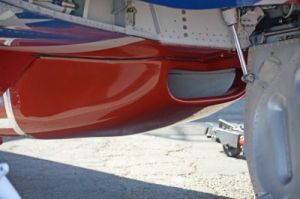 |
| The Miss America team had been doing a lot of work aimed at reaching the next level. This included installing the coolant air scoop that had previously been on the now retired racer Ridge Runner II. With the coolant radiator set higher in the fuselage it is some four inches shallower than a stock unit. Compared to the stock P-51D scoop, the inlet is also reshaped, and enlarged to obtain more effective use of the cooling air. |
Starting in last place during Thursday’s Silver Heat was not an issue as Miss America quickly jumped into the lead and stayed there for the remaining five laps, finishing with a winning speed of 333.937 mph and qualifying to run in the Gold Heats for the rest of the week. As already described, Hisey was disqualified for high flying during the Friday Gold race; however the team was optimistic and developed plans to run the Saturday race at power settings ranging from 3,400 and above. This plan was not able to be implemented as the race was canceled due to the high winds, which meant that they were not able to get a good measurement of the effects of the improvements to the airframe they had implemented.
Even so, Sunday looked to be the race everyone had been looking forward to – Miss America and Dreadnought going all out. Again Miss America had to start from the outside position, but by the time the racers were heading for the Home Pylon for the first time Hisey was established in second position and closing on Dreadnought. He maintained this position throughout the race, always looking for an opportunity to pass, and it was here, while attempting to stay out of the Dreadnought’s wake that he again flew above the 250 foot limit.
It was truly unfortunate that the “testing” intended on Saturday did not occur, as during the Sunday race Hisey found that he could not get the engine to run over about 3,400 rpm – the prop governor had not been reset to run to the intended maximum of 3,600 rpm. This severely limited the maximum power of the engine and he was therefore not able to “jump” out in front – just wait for next year!
#114 Argonaut, a Pratt & Whitney R-2800-CB3 powered single seat Sea Fury FB Mk.11 was flown again by Sherm Smoot, qualifying at 383.704 mph, up from 372.497 mph in 2019, and earning a “Bye” from racing on Thursday. Sherm finished in 2nd place during both the Friday and Sunday Gold races. Again, as in 2019, the racer was lapped by Dreadnought during lap seven of the scheduled eight laps in the Sunday Gold Final.
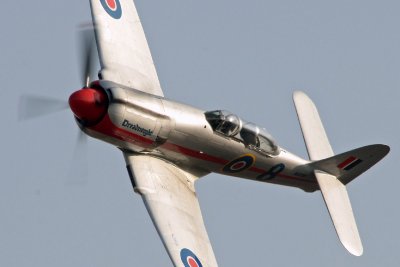 |
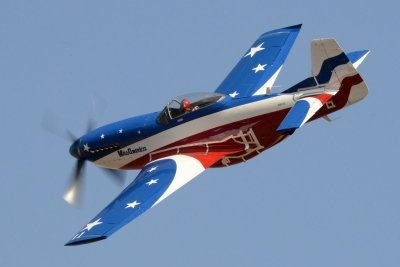 |
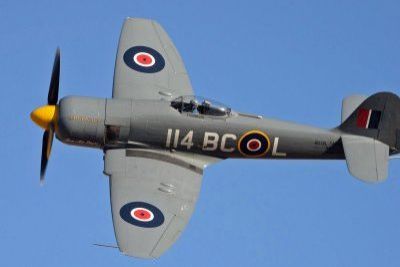 |
| Dreadnought during the Friday Gold heat race, piloted by Joel Swager of Ione, California. Joel won with a speed of 420.319 mph, just ahead of Miss America and besting stable mate Argonaut who finished 362.800 mph. What is not apparent is that the Mustang Miss America was close on Dreadnought’s tail, but was disqualified from a second place finish. | Here is Miss America during the Thursday Silver heat race in which she finished first with a speed of 333.937 mph. Running in this heat was a necessity as a result of not posting a satisfactory qualifying time earlier in the week. | Argonaut flown by Sherm Smoot during the Sunday Gold Final in which he finished in third place, with his position raised to second with the disqualification of Miss America. Having been lapped by the leaders he wasn’t pushing the big R-2800 powered racer, finishing with a seven lap speed of 359.961 mph. |
#924G is a two-seat Sea Fury T.Mk.20, powered by a rare Bristol Centaurus 18-cylinder sleeve valve engine. This year it was flown by Dennis Sanders, who qualified the racer at 368.463 mph. This speed put him 3rd on the qualifying list and resulted in a “Bye” from racing on Thursday. During the Friday and Sunday Gold heats he finished 3rd as well. As in 2019, the racer was lapped by Dreadnought during lap seven of Sunday’s scheduled eight laps.
#2 Goldfinger, is a stock Rolls-Royce Merlin powered P-51D owned by Michael Brown, and this year flown by Bernie Vasquez. He qualified Goldfinger at 350.419 mph, 4th place, and was ceded into the Gold Heats for the week. During the Friday heat he finished 4th with a speed of 340.176 mph and then in the Sunday Final again finished 4th, this time with a speed of 345.446 mph.
Following the races Michael Brown advertised the racer for sale, with a price of $2,500,000. The aircraft was quickly sold, price unknown, to Gary Heck, owner of Korbel Winery. It is reportedly being repainted and is likely to be raced by Will Whiteside at Reno next year. With a few more improvements, and a racing Merlin up front, it could be the match of Dreadnought and Miss America.
#31 Speedball Alice, is a stock Merlin powered P-51D qualified and raced by Dan Vance. His qualifying speed this year was 341.543 mph, placing him 5th in the qualifying lineup, and recipient of a Thursday Bye to the Gold heat.
In Friday’s Gold heat Dan came in fifth, at 315.020 mph, and then duplicated this finish in Sunday’s Gold Final with a speed of 315.767 mph, also unchanged from his finish in 2019. He completed six of the eight Gold Final laps and was lapped twice times by Dreadnought in the Final, their speeds differed by 111 mph!
Dan also flew Speedball Alice in the Heritage Flight – flying in formation with the USAF F-35A.
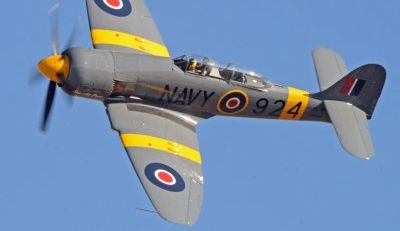 |
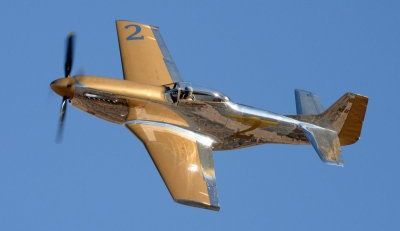 |
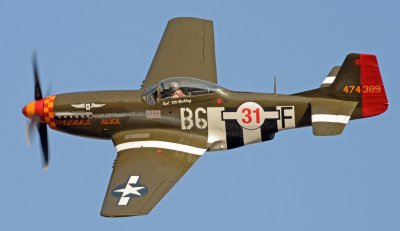 |
| The big Bristol Centaurus-powered Sea Fury TMK 20 #924G piloted by Dennis Sanders of Ione, California and shown here during the Sunday Gold Final. He finished 4th with a speed of 354.937 mph, seven seconds behind stable mate Argonaut. He was awarded third place following the disqualification of Miss America. | #2 Goldfinger, a clipped-wing P-51D piloted by Bernie Vasquez, who qualified at 350.419 mph. Here is Bernie during the Sunday Gold Final where the highly polished racer finished fourth with a speed of 345.446 mph. | #31 Speedball Alice is a stock Merlin-powered P-51D and piloted by Dan Vance, shown here during Friday’s Gold heat, where he posted a speed of 315.020 mph and finished fifth. |
#44 Blondie, is stock Rolls-Royce Merlin powered P-51D flown by Brant Seghetti. Brant has been flying the aircraft at Reno since 1997, and qualified his racer this year at 336.645 mph. This placed him 6th in the qualifying lineup and into the Gold heat, thus receiving a Bye for Thursday. Brant finished both the Friday and Sunday Gold heats in 6th position with speeds of 311.487 and 311.489 mph respectively.
#4 Sweet and Lovely, another stock P-51D, is owned and flown by well known Sport Class champion Jeff LaVelle. The airplane was fresh out of the Planes of Fame restoration shop and qualified at 320.878 mph. In the Friday Silver heat race Jeff finished in second place with a speed of 317.579 mph, and then in the Saturday Silver heat he also finished second, with a speed of 320.541 mph. He won Sunday’s Silver Final with a speed of 327.402 mph.
#0 Spam Can/Dolly, a stock P-51D from the Planes of Fame museum and flown by Mark Moodie, who qualified it at 319.008 mph. In the Thursday Silver Heat he came in second with a speed of 308.910 mph, then on Friday finished 3rd at 314.950. On Saturday Dolly again finished 3rd in the Silver heat, while in the Sunday Silver final Dolly slipped to fourth, posting a speed of 312.721 mph.
The airplane has an interesting paint scheme. The Planes of Fame Museum has been flying the aircraft since 1957 and it has always been known as Spam Can. About nine years ago it was painted to honor WWII pilot J. J. Grant – replicating his paint scheme for Dolly, a very long range Mustang P-51D that flew with the 506th Fighter Group out of Iwo Jima in 1945. The Spam Can name continues on the right side nose cowling.
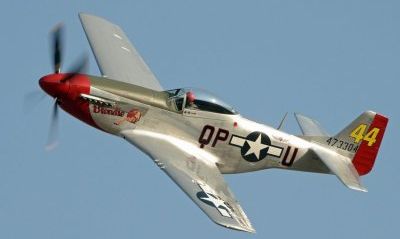 |
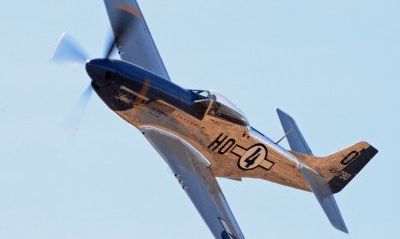 |
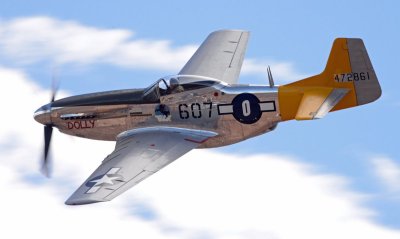 |
| Stock Merlin-powered P-51D #44 Sparky/Blondie during Friday’s Gold heat, where Brant finished in sixth place with a speed of 311.487 mph. | #4 Sweet and Lovely, a stock P-51D Mustang owned and piloted by the Sport Class winning pilot Jeff LaVelle. He qualified at 320.878 mph and finished the week by winning the Sunday Silver Final with a speed of 327.402 mph. Three hours later he won the Sport Class Gold in his Glasair III with a speed of 400.834 mph. | #0 Spam Can/Dolly, a stock P-51D Mustang piloted by Mark Moodie, qualified at 319.008 mph shown here in the Saturday Silver heat, in which he ran 308.455 mph and finished third. |
#81 Wee Willy II, a stock P-51D also from the Planes of Fame museum and flown by Robbie Patterson who qualified at 317.196 mph. In the Thursday Silver Heat Wee Willy II came in third with a speed of 308.909 mph, and then on Friday and Saturday won the Silver Heats with speeds of 318.668 and 321.083 mph respectively. In the Sunday Silver final Wee Willy II finished third, just ahead of Spam Can/Dolly.
#41 Lady B, a stock Merlin powered P-51D, was again piloted by Michael Pfleger, and qualified at 311.013 mph. In the Silver heat races held Thursday, Friday and Saturday Michael finished in fourth place with speeds of 291.735, 296.946 and 292.638 mph respectively. For the Sunday Silver Final he stepped it up, taking second place at 317.043 mph.
#62 Bunny, another stock Merlin powered P-51D came to Reno courtesy of the Palm Springs Air Museum. The airplane was qualified by Tom Nightingale at 296.321 mph and went on to finish 5th in the Silver Heat on Thursday at 288.052 mph. In the Friday Silver Heat he matched this speed, posting 288.093 mph, though this put him in the seventh and last position at the finish. On Saturday Bunny again came in last, this time with a speed of 281.675 mph. Tom ran the Sunday Silver Final race at the same power he had qualified with and matched his qualifying speed with a 296.872 mph for a sixth place finish.
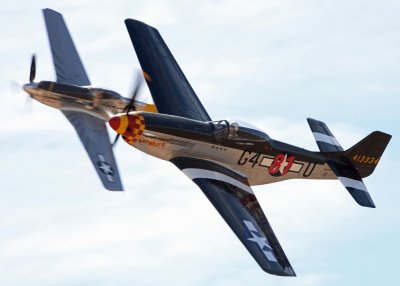 |
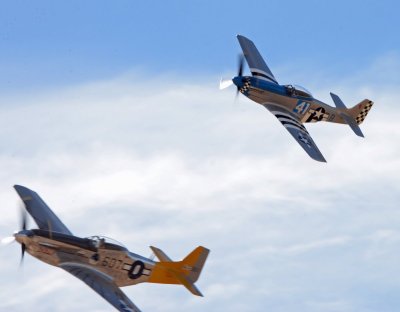 |
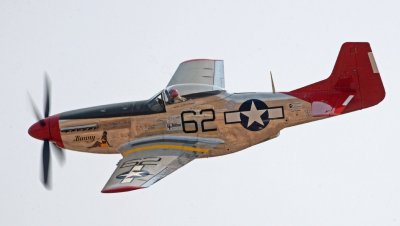 |
| #81 Wee Willy II, a stock P-51D Mustang piloted by Robbie Patterson pulling inside of stable mate Spam Can/Dolly during Sunday’s Silver Final. He qualified at 317.196 mph and beat Dolly every day except Thursday. Wee Willy II won the Friday Silver heat at 318.668 mph and the Saturday Silver heat at 321.083 mph. In all, a very good week for Robbie and Wee Willy II. | #41 Lady B, a stock P-51D overtaking Dolly during the Sunday Silver Final. Pilot Michael Pfleger took the position and finished the race in second place, with Dolly in forth, some nine seconds behind. | #62 Bunny, another racer from the Palm Springs Air Museum. The Mustang was piloted by Tom Nightingale, who qualified at 296.321 mph, then ran in the 280s during the three heat races during the week and stepped it back up to 296.872 mph for a sixth place finish in the Silver Final on Sunday. |
#63 Pretty Polly, was the forth Bell P-63A Kingcobra built and after spending the war doing test work for the NACA was surplused. The Palm Springs Air Museum restored the aircraft as a P-63C and it was flown by Patrick Nightingale. Originally the aircraft had a two-stage Allison V-1710-93 engine; however the auxiliary supercharger has been removed in its current configuration. Patrick qualified the Kingcobra at 294.693 mph and in the Thursday Silver Heat finished sixth at 287.546 mph. Pretty Polly posted her highest speed of the week in the Friday Silver Heat, finishing fifth at 293.278 mph. This was followed on Saturday with a sixth place finish, turning 283.278 mph. During Sundays Silver Final Pretty Polly finished last, in seventh place, with a speed of 291.500 mph.
#55 Man O’ War, a stock Merlin powered P-51D came to Reno sponsored by the Palm Springs Air Museum. The airplane was qualified by Ken Gottschall at 275.107 mph and finish seventh in the Silver Heat on Thursday at 275.539 mph. In the Friday Silver Heat Ken got the speed up to 290.471 mph and finished in sixth place, ahead of Bunny. In the Silver heats on Saturday and Sunday Ken finished in fifth place with speeds of 284.282 and 297.162 mph respectively. This year’s appearance was the first as a Reno racer by this good looking airplane.
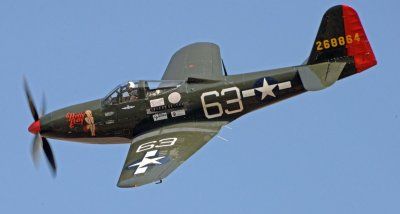 |
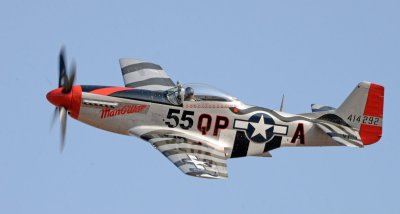 |
| #63 Pretty Polly, a Bell P-63C. The Allison V-1710 powered racer was piloted by Pat Nightingale. Pretty Polly looks and sounds good out on the pylons and was a good competitor with Bunny. Pat finished two heats in sixth place, one in fifth, and was in last place for the Silver Final on Sunday. | #55 Man O’ War, a P-51D Mustang flown by Ken Gottschall qualified at 275.107 mph. Shown here during the Thursday Silver heat where he came in last at 275.539 mph. During the rest of the week he stepped it up and in the Sunday Silver Final came is with a speed of 297.162 mph, placing him in fifth position. |
The Airshow
As an indicator that we are all coming out of this COVID mess the Reno Race Committee was able to arrange for the USAF Thunderbirds military jet demonstration team to appear again. They put on their usual engaging show, much to the delight of the thousands of spectators.
Heritage Flight
This has become a staple at most large airshows and RENO 2021 was no exception. The USAF provided the F-35A Lightening II that put on an awesome performance of tight turns and high-alpha flight. At the conclusion of the performance demonstration the F-35A was joined by the P-51D Mustang Speedball Alice, providing an opportunity to see these two spectacular aircraft flying wingtip to wingtip. We tend to think of the Mustang as a large fighter, but compared to the size and vertical performance abilities of the F-35A make it look 75 years out of date.
The Marine Corps also demonstrated the MV-22 Osprey, which is an awesome performer in its own right. All very interesting.
 |
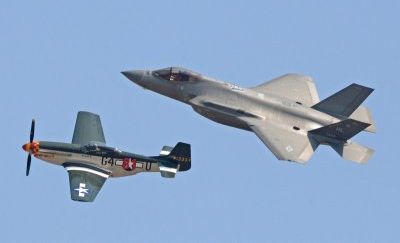 |
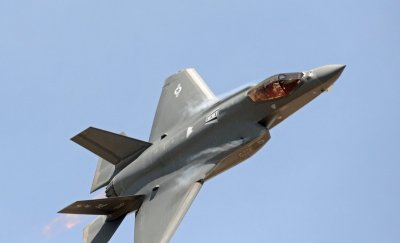 |
| The two “solo” F-16s of the USAF Thunderebirds doing their back to back pass. They are in this position enough that the #5 airplane has its number painted “sunny side up.” | The best single-engine fighters of their day! The North American P-51D Mustang, shadowed by the Lockheed F-35A Lightning II. The F-35A was making its first appearance at Reno, with a marvelous demonstration of its maneuvering capabilities by Captain Kristin “Beo” Wolfe. Her performance was amazing – note the condensation contrails forming in the high desert dry air due to the high g-load during this low-level turn. | |
The Other Racing Classes
While this Aircraft Engine Historical Society article focuses on the big racers in the Unlimited Class at Reno, there is a lot of other racing going on as well. The Jet Class, Sports Class, T-6 Class, Biplanes and Formula One classes all have a full race schedule, with racing starting at eight in the morning and continuing until late in the afternoon. In total, there were 54 heat races during the four days of racing, with 107 qualifying racers. There is a LOT of good racing going on at Reno!
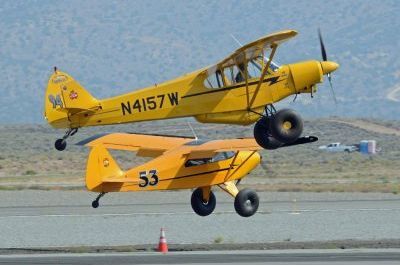 |
 |
| STOL Bronze Bracket competitors Rick Boardman in his Super Cub #94 drag racing Joe Dory in a Dickman Pacer 175, #53. | STOL pilot Toby Ashley flies #56 SARGE, a Carbon Cub in the STOL Class. It is a highly modified airplane with a supercharged Jet Ski engine, custom reduction gear and propeller, while also having nitrous injection for that added boost! Toby is a regular winner when STOL Drag racing, and took the Gold at Reno this year. In the Gold bracket winning times are on the order of 58 seconds, while the Silver bracket best times are in the range of 1:08 to 1:10 minutes, and the Bronze bracket times are 1:15 or more. Very competitive. |
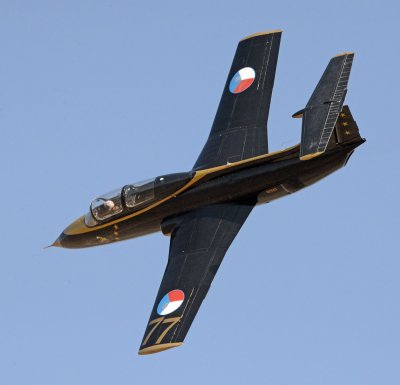 |
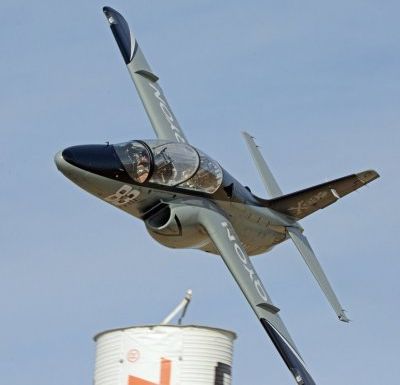 |
| This year there were 18 Jet Class racers, up from 14 in 2019. This included eleven L-39s, six L-29s and a Marchetti S-211. Qualifying speeds ranged from 313.979 mph for the Marchetti, with the next slowest, an L-29, coming in at 379.628 mph and the fastest jet was #77 Viper, at 502.063 mph. Pete Zaccagnino in #77 Viper was the top qualifier and took the Gold in the Sunday Final with a speed of 502.362 mph. | Jet Class Marchetti S-211 #83 Vader, piloted by Scott Farnsworth in the Sunday Bronze Jet Final, where he finished fifth with a speed of 384.039 mph. This was much improved over his qualifying speed of 313.979 mph. As you can see, Scott ran a really tight course in the attractive jet. |
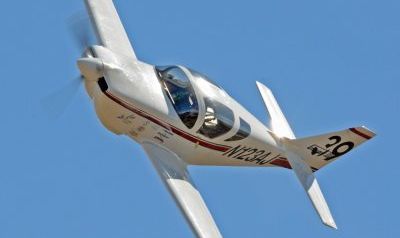 |
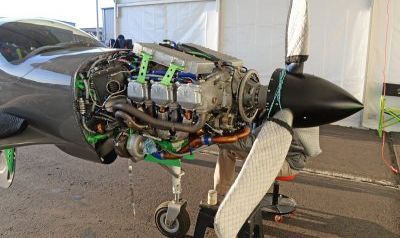 |
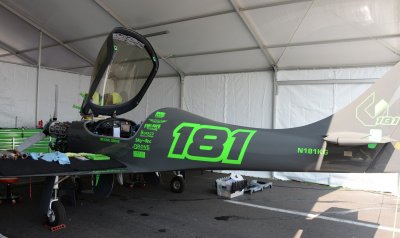 |
| Sport Class racer #39, a turbosupercharged Glasair III flown by Jeff LaVelle, qualified second behind another turbosupercharged Glasair III, #24, with speeds of 392.791 and 396.648 mph respectively. Jeff went on to win the Sunday Gold Sport Final with a speed of 400.834 mph! At the end of the race second place was held by the 2019 winner, Andrew Findlay, in his STIHL sponsored Lancair Super Legacy – however he had cut a pylon and was penalized 12 seconds, dropping him to third place. | Sport Class racers may be any kit or amateur built airplane certificated by the FAA, and are capable of at least 200 mph. Engines must be under 1,000 in³ displacement, but otherwise unlimited as they allow turbosuperchargers, ADI, and even nitrous oxide injection. | Sport Class racers are really into the technology of how to go fast! Racer #181 did not qualify for this year’s race because the fuel injectors on the six cylinder dual turbo-supercharger fitted engine drew so much current on his qualification run that the electrical circuit breaker tripped and the battery quickly discharged, all leading to serious detonation and damage to the engine. The team quickly changed the cylinder banks and pistons, which are liquid-cooled Centurion monoblocks from AC Aero that fit onto the standard Lycoming 540 in³ crankcase. These banks are available for 583 and 660 in³ configurations. As you can see, the clean installation includes turbos and intercoolers. Too bad they didn’t get to run this year. |
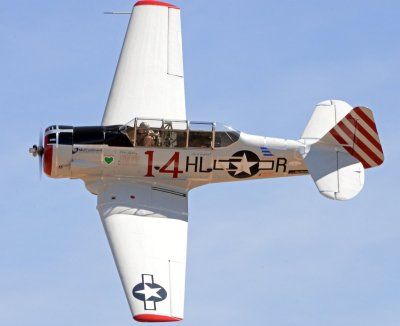 |
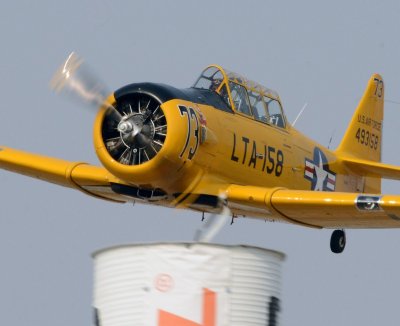 |
| Twelve racers qualified for the “stock” T-6 class with speeds from 187.886 to 236.967 mph. The top qualifier was Chris Rushing in his #14 Barons Revenge, he stayed out in front all week, wining each of his heats and taking the Sunday Gold with a speed of 234.862 mph. He is shown here on his way to the win in Sunday’s Gold final. | Sometimes the racers can get up close and personal, like here when pilot Loren Marburg, in T-6G #73 Miss Humboldt Hunny, flies past Pylon #8 in Friday’s Heat 2C. |
 |
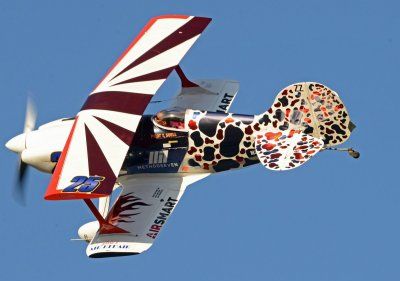 |
| Bi-Plane Class winner fastest qualifier was Jake Steward in the Pitts S-1 #10 Bad MoJo. He qualified at 214.959 mph. Unfortunately, again this year the Sunday Gold final had to be canceled due to high winds, though Jake was to be in the first starting position. | Bi-Plane #25 Shake N Bake, a Pitts S-1C piloted by Tommy Suell from Okinawa, Japan, in Saturday’s Heat 3A where he finished third with a speed of 196.806 mph. |
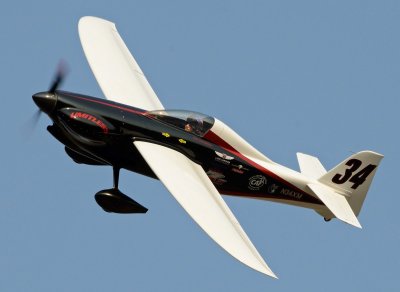 |
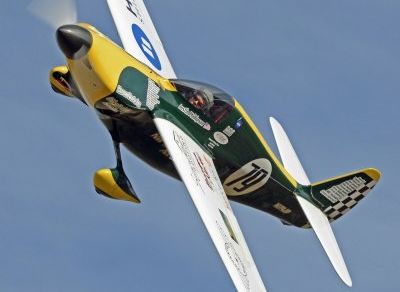 |
| Formula One racer #34 Limitless is a Snoshoo SR-1 piloted by Justin Meaders of Mineral Wells, Texas. Justin qualified in second at 243.764 mph and won the Friday Heat 2A with a speed of 234.765 mph. This photo was taken during that race. Justin also won the eight lap Sunday Gold Final with a speed of 237.020 mph. | This year’s Formula One field had fifteen qualifiers, with #79 No Strings Attached placing third with a speed of 231.273 mph. Pilot Justin Philipson went on to place second in the Sunday Formula One Gold. The aircraft is a Shoestring design racer who finished the Gold with a speed of 225.567 mph. |
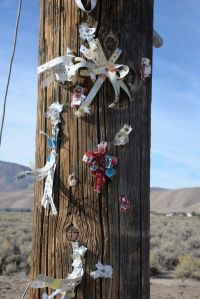 |
It has become a tradition at Reno’s Pylon 8 that the Pylon Judges literally “post” their wrist bands on the pylon pole at the end of the races. There’s a lot of teamwork and camaraderie amongst the thousands of volunteers that make Reno what it is. |
Summary
There was a lot of good racing at Reno this year. Yes, the speeds are down without the parade of highly modified Unlimiteds, but the elements are there as Dreadnaught and Miss America showed. There are also rumors that some of the previous “big boys” may be returning as well as a couple of new racing projects being worked on.
Even so, the “stock” Unlimited racers give the fans a good race: the speeds are just numbers when there is a competitive spirit between the racers jockeying for position.
See you all at Reno 2022!
| Race No. | Name | Aircraft Type | Pilot | Qualifying mph |
Thursday mph |
Friday mph |
Saturday mph |
Sunday mph |
|---|---|---|---|---|---|---|---|---|
| 8 | Dreadnought | Hawker TMK20 Sea Fury / R-4360 | Swager, Joel | 430.788 | BYE | 420.319G1 | Race Canx¹ | 426.896G1 |
| 114 | Argonaut | Hawker Mk 11 Sea Fury / R-2800 | Smoot, Sherman | 383.704 | BYE | 362.800G2 | Race Canx¹ | 359.961G2³ |
| 924 | #924G | Hawker TMK20 Sea Fury / Centaurus | Sanders, Dennis | 368.463 | BYE | 356.966G3 | Race Canx¹ | 354.937G3³ |
| 2 | Goldfinger | F-51D Mustang | Vasquez, Bernie | 350.419 | BYE | 340.176G4 | Race Canx¹ | 345.446G4³ |
| 31 | Speedball Alice | P-51D Mustang | Vance, Dan | 341.543 | BYE | 315.020G5 | Race Canx¹ | 315.767G5² |
| 44 | Blondie | P-51D Mustang | Seghetti, Brant | 336.645 | BYE | 311.487G6 | Race Canx¹ | 311.489G6² |
| 4 | Sweet and Lovely | P-51D Mustang | LaVelle, Jeff | 320.878 | DNS | 317.579S2 | 320.541S2 | 327.402S1 |
| 0 | Dolly/Spam Can | P-51D Mustang | Moodie, Mark | 319.008 | 308.910S2 | 314.950S3 | 308.455S3 | 312.721S4 |
| 81 | Wee Willy II | F-51D Mustang | Patterson, Robbie | 317.196 | 308.909S3 | 318.668S1 | 321.083S1 | 312.841S3 |
| 41 | Lady B | P-51D Mustang | Pfleger, Michael | 311.013 | 291.735S4 | 296.946S4 | 292.638S4 | 317.043S2 |
| 62 | Bunny | P-51D Mustang | Nightingale, Tom | 296.321 | 288.052S5 | 288.093S7 | 281.675S7 | 296.872S6 |
| 63 | Pretty Polly | P-63C Kingcobra | Nightingale, Patrick | 294.693 | 287.546S6 | 293.278S5 | 283.701S6 | 291.500S7 |
| 55 | Man O’ War | P-51D Mustang | Gottschall, Ken | 275.107 | 275.539S7 | 290.471S6 | 284.282S5 | 297.162S5 |
| 11 | Miss America | P-51D Mustang | Hisey, Brent | No Time | 333.937S1 | DQ | Race Canx¹ | DQ |
|
S = Silver Heat Race, G = Gold Heat Race, DNS = Did Not Start, DNF-# = Did Not Finish-lap out. DNQ = Did Not Qualify, DNR = Did Not Race, DQ = Disqualified, BOLD = 1st Place Heat Winners, Number following Heat letter is finishing position ¹ Race Canceled due to High Winds ² Completed 6 of 8 laps ³ Completed 7 of 8 laps |
||||||||
Send mail to
![]() with questions or comments about this web site.
with questions or comments about this web site.